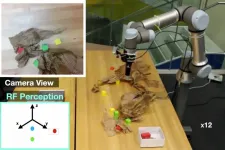(Press-News.org) On the afternoon of April 13, 2018, a large wave of water surged across Lake Michigan and flooded the shores of the picturesque beach town of Ludington, Michigan, damaging homes and boat docks, and flooding intake pipes. Thanks to a local citizen's photos and other data, NOAA scientists reconstructed the event in models and determined this was the first ever documented meteotsunami in the Great Lakes caused by an atmospheric inertia-gravity wave.
An atmospheric inertia-gravity wave is a wave of air that can run from 6 to 60 miles long that is created when a mass of stable air is displaced by an air mass with significantly different pressure. This sets in motion a wave of air with rising and falling pressure that can influence the water below, as it synchronizes with water movement on the lake's surface like two singers harmonizing.
"That meteotsunami was hands down off the chart awesome," said Debbie Maglothin of Ludington who took photos of the event. "The water in between the breakwaters didn't go down like the water on the outside of them, so it created waterfalls that cascaded over the breakwaters. Had this event occurred during summer it could have washed people right off the breakwaters."
Meteotsunamis generated from this type atmospheric condition are common around the globe, but in the Great Lakes, the few well documented meteotsunamis have been driven by sudden severe thunderstorms where both winds and air pressure changes have played significant roles.
Combining water and weather models
While there are currently no forecast models that effectively predict meteotsunamis in the U.S., new NOAA research based on the Ludington wave demonstrates that existing NOAA numerical weather prediction models and hydrodynamic forecast models may enable scientists to predict these meteotsunami-driving atmospheric waves minutes to hours in advance. The research is published in a special edition of the journal Natural Hazards about meteotsunamis. (https://rdcu.be/b6sNA)
"The good news with this type of meteotsunami is that it is easier to predict than ones triggered by thunderstorms," said Eric Anderson, an oceanographer at NOAA's Great Lakes Environmental Research Laboratory and lead author of the study. "Our short-range weather models can pick up these atmospheric pressure waves, whereas predicting thunderstorms is more difficult."
Meteotsunamis are a lesser known category of tsunami. Unlike the more well known tsunami -- such as the catastrophic 2004 Boxing Day tsunami in Indonesia, which was caused by an earthquake on the seafloor, meteotsunamis are caused by weather, in particular some combination of changing air pressure, strong winds and thunderstorm activity.
"Because the lakes are relatively small, meteotsunamis typically need more than a jump in air pressure to drive them," said Anderson. "That's where the thunderstorms and wind come in to give them a push."
Great Lakes have history of meteotsunamis
Meteotsunamis occur around the world, and are known to occur in the United States primarily on the Great Lakes and along the East and Gulf of Mexico coasts. Meteotsunami waves in the Great Lakes can be particularly insidious because they can bounce off the shoreline and come back again when the skies are clear. They are relatively rare and typically small, the largest producing three to six foot waves, which only occur about once every 10 years.
Predicting these waves in advance would give communities potentially life-saving warnings and would allow residents and businesses to take measures to better protect property. The Ludington meteotsunami resulted in some property damage but no serious injuries. Had the meteotsunami struck in the summer when swimmers, anglers and vacationers flock to the lakeshore beaches, parks and waters, it might have been a different story, as was the case with a meteotsunami that took the lives of eight people in Chicago in June 1954.
"It's a gap in our forecasting," said Anderson. "With this study and other research we are getting closer to being able to predict them in advance."
INFORMATION:
The new research is one of three papers authored by NOAA scientists appearing in the Natural Hazards special issue. The paper originally published online in Aug 2020 and was released as part of a special issue on meteotsunamis on March 31, 2021. Another research paper looks at the state of meteotsunami science and what will be needed to put in place effective operational forecast models for meteotsunamis in the Great Lakes and along the East Coast. A third paper demonstrates the potential of using real-time measurements and numerical models to forecast meteotsunami impacts on coastal areas.
In recent years, robots have gained artificial vision, touch, and even smell. "Researchers have been giving robots human-like perception," says MIT Associate Professor Fadel Adib. In a new paper, Adib's team is pushing the technology a step further. "We're trying to give robots superhuman perception," he says.
The researchers have developed a robot that uses radio waves, which can pass through walls, to sense occluded objects. The robot, called RF-Grasp, combines this powerful sensing with more traditional computer vision to locate and grasp items that might otherwise be blocked from view. The advance could one day streamline e-commerce fulfillment in warehouses or help a machine pluck a screwdriver from a jumbled toolkit.
The research will be presented in May at the IEEE International ...
Plant inducible defense starts with the recognition of microbes, which leads to the activation of a complex set of cellular responses. There are many ways to recognize a microbe, and recognition of microbial features by pattern recognition receptors (PRRs) outside the cell was long thought to activate the first line of defense: Pattern Triggered Immunity, or PTI. To avoid these defense responses, microbes of all kinds evolved the ability to deliver effector molecules to the plant cell, either directly into the cytoplasm or into the area just outside the cell, where they are taken up into the cytoplasm. ...
New research published today in the journal Blood Advances is the first to show that restricting calories, reducing fat and sugar intake, and increasing physical activity may boost the effectiveness of chemotherapy for older children and adolescents with leukemia. This intervention, which improved chemotherapy outcomes for children being treated at two institutions, will be further studied through a national trial later this year.
B-cell acute lymphoblastic leukemia (B-ALL), a cancer affecting the white blood cells in the bone marrow, is the most common type of cancer in children. In the study, researchers assessed the effects of diet and exercise on 40 individuals aged 10-21 undergoing chemotherapy at ...
In some cancers, including leukemia in children and adolescents, obesity can negatively affect survival outcomes. Obese young people with leukemia are 50% more likely to relapse after treatment than their lean counterparts.
Now, a study led by researchers at UCLA and Children's Hospital Los Angeles has shown that a combination of modest dietary changes and exercise can dramatically improve survival outcomes for those with acute lymphoblastic leukemia, the most common childhood cancer.
The researchers found that patients who reduced their calorie intake by 10% or more and adopted a moderate exercise program immediately after their diagnosis had, on average, 70% less ...
For years, research to pin down the underlying cause of Alzheimer's Disease has been focused on plaque found to be building up in the brain in AD patients. But treatments targeted at breaking down that buildup have been ineffective in restoring cognitive function, suggesting that the buildup may be a side effect of AD and not the cause itself.
A new study led by a team of Brigham Young University researchers finds novel cellular-level support for an alternate theory that is growing in strength: Alzheimer's could actually be a result of metabolic dysfunction in the brain. In other words, there is growing evidence that diet and lifestyle are at the ...
Los Angeles (April 1, 2021) -- Overweight children and adolescents receiving chemotherapy for treatment of leukemia are less successful battling the disease compared to their lean peers. Now, research conducted at the END ...
Buildings are responsible for 40 percent of primary energy consumption and 36 percent of total CO2 emissions. And, as we know, CO2 emissions trigger global warming, sea level rise, and profound changes in ocean ecosystems. Substituting the inefficient glazing areas of buildings with energy efficient smart glazing windows has great potential to decrease energy consumption for lighting and temperature control.
Harmut Hillmer et al. of the University of Kassel in Germany demonstrate that potential in "MOEMS micromirror arrays in smart windows for daylight steering," a paper published recently in the inaugural issue of the Journal of Optical Microsystems.
"Our smart glazing ...
A highly contagious SARS-CoV-2 variant was unknowingly spreading for months in the United States by October 2020, according to a new study from researchers with The University of Texas at Austin COVID-19 Modeling Consortium. Scientists first discovered it in early December in the United Kingdom, where the highly contagious and more lethal variant is thought to have originated. The journal Emerging Infectious Diseases, which has published an early-release version of the study, provides evidence that the coronavirus variant B117 (501Y) had spread across the globe undetected for months when scientists discovered it.
"By the time we learned about the U.K. variant ...
A possible explanation for why many cancer drugs that kill tumor cells in mouse models won't work in human trials has been found by researchers with The University of Texas Health Science Center at Houston (UTHealth) School of Biomedical Informatics and McGovern Medical School.
The research was published today in Nature Communications.
In the study, investigators reported the extensive presence of mouse viruses in patient-derived xenografts (PDX). PDX models are developed by implanting human tumor tissues in immune-deficient mice, and are commonly ...
Boulder, Colo., USA: The Geological Society of America regularly publishes
articles online ahead of print. For March, GSA Bulletin topics
include multiple articles about the dynamics of China and Tibet; the ups
and downs of the Missouri River; the Los Rastros Formation, Argentina; the
Olympic Mountains of Washington State; methane seep deposits; meandering
rivers; and the northwest Hawaiian Ridge. You can find these articles at
https://bulletin.geoscienceworld.org/content/early/recent
.
Transition from a passive to active continental ...




